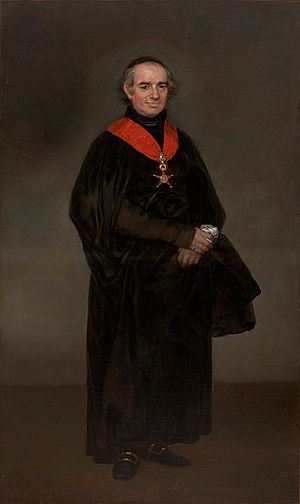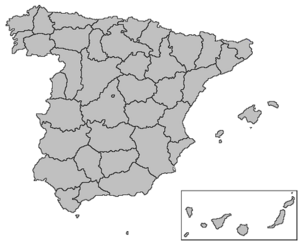Juan Antonio Llorente facts for kids
Quick facts for kids
Juan Antonio Llorente
|
|
|---|---|

Portrait of Don Juan Antonio Llorente by Francisco Goya (1809–1813)
|
|
| Born | March 30, 1756 |
| Died | February 5, 1823 (aged 66) |
| Education | University of Zaragoza |
| Occupation | Historian |
Juan Antonio Llorente (born March 30, 1756, died February 5, 1823) was an important Spanish historian. He is best known for his detailed writings about the Spanish Inquisition. He was born in Rincón de Soto, a town in La Rioja, Spain, and later passed away in Madrid.
Contents
Early Life and Career
Juan Antonio Llorente grew up with his uncle after his parents died. He went to the University of Zaragoza to study. After becoming a priest, he worked for the bishop of Calahorra starting in 1782.
In 1785, he became a special officer for the Holy Office (also known as the Inquisition) in Logroño. By 1789, he was the general secretary for the Inquisition in Madrid. The Inquisition was a powerful church court that investigated people accused of not following the rules of the Catholic faith.
Working with the French Government
During the Peninsular War around 1808, Spain was invaded by France. Juan Antonio Llorente decided to support the French government led by Joseph I of Spain, who was Napoleon Bonaparte's brother. People who supported the French were called afrancesados.
For a few years, Llorente helped carry out new laws. These laws included closing down monasteries and examining the old records of the Spanish Inquisition. He also argued that the Spanish church should follow the new French king. In 1810, he suggested dividing Spain into new areas, similar to how France was organized. However, this plan was never put into action because of the ongoing war.
Life in Exile and Major Works
When King Ferdinand VII of Spain returned to power in Spain in 1814, Llorente moved to France. There, he published his most famous book, Histoire critique de l'Inquisition espagnole (which means Critical History of the Spanish Inquisition). This book came out between 1817 and 1818.
His book was very important because it was one of the first times anyone had written such a detailed account of the Inquisition using official documents. It was translated into many languages, like English, German, and Italian, and became very popular across Europe.
While Llorente was in France, his home in Spain was damaged. A large crowd destroyed his library, which had over 8,000 rare books and old papers. Some of these valuable items could not be replaced.
Later Life and Legacy
In 1820, there was a political change in Spain led by Rafael de Riego. Llorente supported this new, more liberal government. However, he was later found to be involved with a secret group called the Carbonari. He also published another book called Portraits politiques des papes in 1822. Because of these actions, he was ordered to leave France.
Juan Antonio Llorente's historical work has been discussed a lot. Some people have questioned how accurate he was. But even though he might not have been perfectly exact in every detail, he honestly used many important documents about the Inquisition. Many of these documents no longer exist today.
Besides his famous book on the Inquisition, Llorente wrote other works. These include Memorias para la historia de la revolución de España (Memories for the History of the Spanish Revolution) and Noticias históricas de las tres provincias vascongadas (Historical News of the Three Basque Provinces). He also wrote an autobiography about his own life. His notes also helped later historians write about important figures like Antonio Pérez (statesman).
See also
 In Spanish: Juan Antonio Llorente para niños
In Spanish: Juan Antonio Llorente para niños


